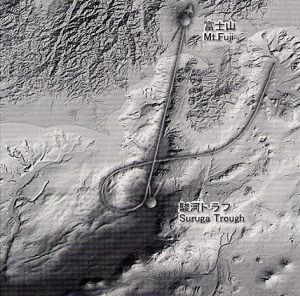日本近海海底地形の動画(パノラマ海底地形)
Animation display of ocean bottom topography near Japan
永田 豊・鈴木 亨
Dr Yutaka Nagata and Dr Toru Suzuki
種々の海洋研究分野で、海底地形についての正確な情報は非常に重要である。しかし、海水は光を通さないため、海底地形を直感的に捉えるのは難しい。MIRCの普及啓蒙活動の一環として、海水を取り除いた形で、あたかも航行中の潜水・飛行艇のフロントグラスから日本近海の海底地形を眺めるような動画と、多数の地点から地形の鳥瞰図を得られるような動画ソフトの作成を行なった。日本近海を16の海域に分け、それぞれの海域で興味深い海底地形を眺めるのに適した潜水艇の1つの航路と、鳥瞰図を見ることのできる複数の地点を設定した。その中から駿河湾海域を例にとって説明しよう。図1に海域図を示すが、この画面では、他に海域の地形構造の簡単な説明も与えている。この海域での代表的地形は湾軸に沿って北に伸びる深い駿河トラフで、ほとんど湾奥にまで達している。図に矢印をつけた曲線が示されているが、これが潜航艇の航路である。駿河湾では比較的単純な航路が予定されており、相模湾内から出発して、南西に進路航路を取り、伊豆半島先端沖から西に転じ、駿河トラフを横切った後ループ状の航路を取る。その後、トラフをその軸に沿った形で、沖合から真北に進む。この部分では潜水艇は真直ぐ富士山に向かうことになる。動画の一場面として、駿河トラフの海底近くから、海底峡谷を通して見た富士山を図2に示す。この動画では地形をとらえ易いように鉛直スケールを水平スケールに対して数倍拡大して示しているので、富士山は実際よりやや尖って見える。駿河湾の動画では、潜水艇は湾奥近くで空中に飛び出し、富士山の火口が眺められるところで終わっている。
図1の地図では、2つの丸いボタンが示されているが、この地点で鳥瞰図を得ることができる。この海域では2つしか設定していないが、日本近海全体では、図3に示すように46地点が設定されていて、特徴的な、あるいは興味深い海底地形のほとんどを見ることができる。図のボタンをクリックすることによって、鳥瞰図が得られるのであるが、視点の高さは海面やや上と、ある程度の高度からの2つを選択できる。駿河湾海域南方の地点のやや高い位置から眺めた鳥瞰図を、このニュースレターの表紙に示すが、前述の動画よりも、通常より印象的な眺めが得られる。地図上のボタンのそれぞれに2つの線分が付けられているが、これは初期の見通しの範囲を示すものである。マウスを操作することによって、水平方向に360度、上下方向に180度、視線の方向を変えることができる(その意味で一種の動画表示)。
海底地形に関する基礎的なデータは500mメッシュのJ-EGG500を用いているが、沿岸域では粗すぎるので、浅田昭東大教授が作成したより細かいデータセット(相模湾海域で50x50mグリッド、東京湾海域では90x90mグリッド)の提供を受けて用いている。(浅田教授は水路部在職中にJ-EGG500の作成に尽力された。)陸上の地形については国土地理院の50mメッシュのデータを用いている。2つの動画全体が1枚のCD-ROMに収められており、通常のパソコンでみることができるようになっている。われわれのこのような試みが、多方面の方々のお役に立てるものと考えている次第である。
Accurate knowledge of bottom topography is essential for researches on ocean in various fields. However, seawater is too opaque for us directly to view ocean bottom scenery. As one of our efforts on popularization of oceanographic knowledge, we developed two kinds of animation displays of ocean bottom topography near Japan. One is walk through animation, in which you can see ocean-bottom scenery from a front glass of a submarine/flying boat. Another one is to show bird's eye views from various spots.
We divided areas near Japan into 16 sub-domains. One of the sub-domains, Suruga Bay area, is shown in Fig. 1. An explanation of the topographic feature is also given. In the map, there one line with arrow along which walk through animation is shown, and several round buttons (two in the case of Fig. 1 ) at the positions where bird's eye views are shown. The most spectacular topography in Suruga Bay is the very deep canyon, Suruga Trough, which extends northwards along the bay axis from offshore, and reaches almost the bay head. Here, we set rather simple navigation rout: the boat starts from the center of Sagami Bay, and goes southwestward along the coast of Izu Peninsula, and turns westward to cross Suruga Trough. After taking a circular path, it navigates northward along Suruga Trough. The rout is just pointing to Mt. Fuji. One example of the scenery from the front glass of the boat is shown in Fig. 2. You can see the configuration of Suruga Trough and Mt. Fuji faraway through the canyon. The boat comes out from sea surface near the bay head to fly over Mt. Fuji. You can see the crater of Mt. Fuji in the last scene of the animation. Vertical scale is taken as several times larger than horizontal scale in our animation, in order to illustrate the scenery more understandable. So, the shape of Mt. Fuji is a little sharpened than our real image.
The bird's eye view would give more concrete image on ocean bottom topography. If one of the round buttons in map of Fig. 1 is clicked, you will get the bird's eye view as shown in the face page of this News Letter. The height of the observing points can be selected whether a little above the sea surface or the higher level. The two segments attached to the round button in the map (Fig. 1 ) indicate the range of vision in the initial stage. Eye direction can be changed both horizontally for 360 degrees and vertically for 180 degrees by maneuvering the mouse. The bird's eye view well demonstrates the characteristic nature of Sagami Bay. The number of observing points is 46 in total (see Fig. 3 for their positions), and we believe that almost all of the important and speculative sceneries can be seen from these points.
We hope that our bottom topography animation of two kinds can give good sea bottom images for scientists and for public people. The total software described above is installed in a single CD-ROM, and can be operated by usual personal computer. The digitized bathymetry dataset, J-EGG500 (JODC-Expert Grid Data for Geography) of 500m x 500m grid is basically used in our animation displays. However, it is too coarse to display the detailed topography in coastal areas and bays. So, for several coastal sub-domains, we used much more detailed grid data (50 x 50 m grid for Sagami Bay, and 90 x 90 m grid for Tokyo Bay), which were provided by Prof. Akira Asada of University of Tokyo, who contributed to establish J-EGG500 when he was in Hydrographic Department, MSA. As to the height distribution on land, 50 x 50 m grid data provided by Geographical Survey Institute, Japan is used.

Fig. 1
Sub-domain map for Suruga Bay area. The line with arrow indicates the navigation rout of the submarine/flying boat. Round buttons indicate the spots, from where bird's eye views are available. Two segments attached to each of the round buttons show range of view in the initial stage.
Fig. 2
View from the front glass of the boat, when it navigates along the axis of the Suruga Trough (see Fig. 1). Mt. Fuji is seen through the canyon.
Fig. 3
Spots from where you can see the bird's eye views of bottom topography. 41 spots are prepared in total. JEGG500 bathymetry dataset is available in the region shown here.